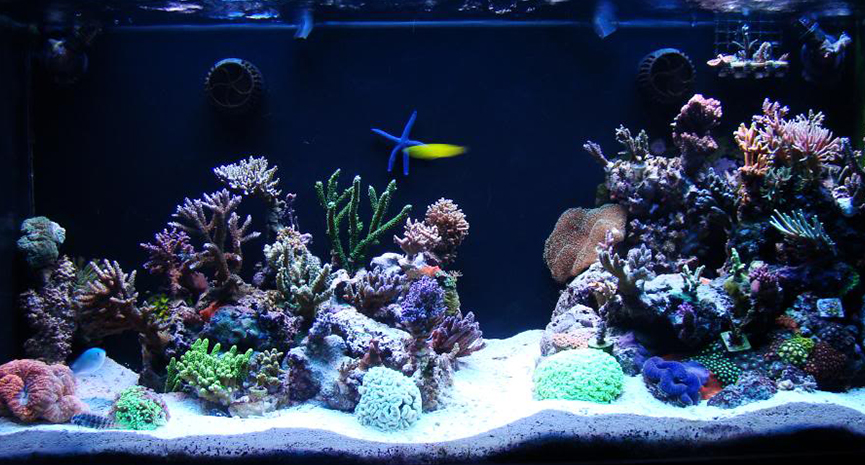For many aquarists, the joy of keeping an aquarium is not only about watching colorful fish dart around in the living room, it is also a way of learning more about the delicate web we call an ecosystem and how dead matter and living organisms interact with each other to create an environment where life can not only exist but flourish. It therefore comes as no surprise that you can find a lot of environmentally conscious aquarists, and that many of today’s expert biologists and wildlife authorities were steered into the path of environmental science at a very young age while striving to keep the inhabitants of their fish tank alive. Keeping an aquarium can unfortunately be a problematic hobby for the environmentally conscious, but don’t loose heart–there are loads of things that you can do to make your aquarium less of a burden for mother earth. As a matter of fact, many aquarists have actually helped in preservation work, e.g. by keeping and breeding endangered fish from severely damaged habitats, thus preventing species from becoming completely eradicated.
Pick species that appreciate
the same temperature as you do
Keeping an aquarium heated can require loads of energy and dig a large hole in your pocketbook. Many aquarists automatically chose tropical species in need of a temperature in the 75-82 F (24-28 C) range, despite the fact that they keep their homes heated up to 70F (21 C) or so. By choosing subtropical species that prefer roughly the same temperature as you do you can save considerably amounts of energy in the long run. It can however still be a good idea to keep a heater with a thermostat in the aquarium as a precaution against sudden drops in temperature. The smaller your aquarium, the more rapidly it will loose heat if the surrounding temperature drops. Choose a supplier that sells green electricity.
Never release fish into the wild
If you for any reason cannot care for your aquarium inhabitants anymore, you need to find them a new keeper or euthanize them. It might be tempting to release them into the wild, but this is a big no-no. Releasing living organisms into environments where they don’t belong can wreck havoc with existing ecosystems and must therefore be avoided. Even if you keep species that occur naturally in your local environment you shouldn’t release them back into the wild because they may have come in contact with non-native bacteria, viruses, parasites etcetera in the aquarium that could cause problems for wild flora and fauna.
Purchase locally bred or caught fish
Instead of purchasing fish that have to be flown in from the other side of the planet, you can search for fish that are being bred or caught in your area, country or (at least) part of the world. As a bonus for you, locally bred fish are often better acclimatized to the tap water in your area and more prone to breed in captivity.
Avoid unsuitable harvesting methods
Unfortunately, devastating harvesting methods like dynamite fishing are still fairly common within the aquarium trade. Always make an effort to find out which technique that has been used to catch the fish you’re interested in purchasing. It can be hard to find unbiased information, but it is still worth trying. Paying a little extra for fish that has not been caught with dynamite and similar can also be a very sound investment since unsuitable harvesting methods tend to cause a lot of damage to the fish and decrease its chances of survival in captivity.
Participate in breeding programs
By participating in a breeding program you can help supply the aquarium market with captive bred fish and ease the strain on wild populations. You can naturally do this on your own as well, but joining a breeding program is a great way of getting information on how to breed high quality fish and avoid common pitfalls. You may also be able to purchase or borrow hard to find species to use in your breeding efforts, especially if you have had success in breeding similar species in the past.
Keep the fish alive
This last point might seem like a no-brainer, but many beginner aquarists are coaxed by fish shops into thinking that four months is a perfectly normal lifespan for all sorts of aquarium fish and that you should expect to constantly purchase new fish to keep your tank populated. It is true that some species have a natural life span of less than six months, but the overwhelming majority of known fish species live much longer than this and there are actually quite a few species that will live for 10 years or more in a well kept aquarium. If aquarists all over the world would become better at actually keeping their fish alive, less energy would have to be devoted to transporting replacement fish, and it would also alleviate the strain on wild populations of desirable aquarium fish.
So, how can we increase our chances of keeping healthy and long-lived fish in our tanks? First and foremost, always read up on each species you wish to keep before you make a purchase. By learning about a species preferred environment, temperature, water chemistry, diet, tank mates, and so on, you will be more apt at keeping it alive throughout its natural life span. Do not mix species with different preferences in water chemistry, temperature and similar. You might very well be able to keep them alive, but they will not thrive and they will be more prone to health problems which increase the risk of an untimely death.
It is also important to read up on aquarium management techniques and always strive to increase ones knowledge on general aquarium maintenance. Do not hesitate to ask more experienced aquarists for advice. Today, the Internet has made it easy to keep in touch with aquarists from all over the world through aquarium forums and e-mail. If you’re lucky, there will also be a local aquarium club in your area.





